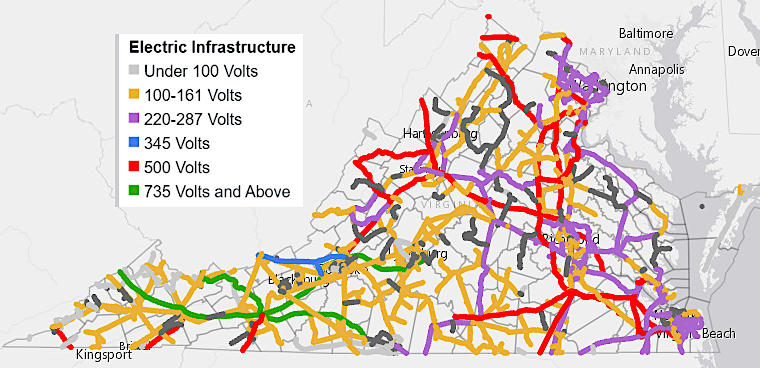
high-voltage transmission lines crisscross Virginia, but are scarce on the Eastern Shore
Source: Virginia's Land and Energy Navigator (VALEN)

high-voltage transmission lines crisscross Virginia, but are scarce on the Eastern Shore
Source: Virginia's Land and Energy Navigator (VALEN)
Today, almost all Virginia electricity is generated at a few centralized locations, typically large power plants fueled by coal, nuclear energy, natural gas, or falling water. Utility-scale solar facilities also generate electricity which is "exported" from the site covered with solar panels to customers located elsewhere.
The electricity moves as alternating current, at 60 Hertz frequency, through high-voltage transmission lines and low-voltage distribution lines to the site where it is used. At substations, transformers lower the voltage to a level suitable for the distribution lines, which are closer to the ground and have a narrower right-of-way from which vegetation has been cleared. The electricity is utilized at the ultimate "load center" to light a bulb, power a motor, charge a cell phone, heat a structure, cook a dinner, etc.
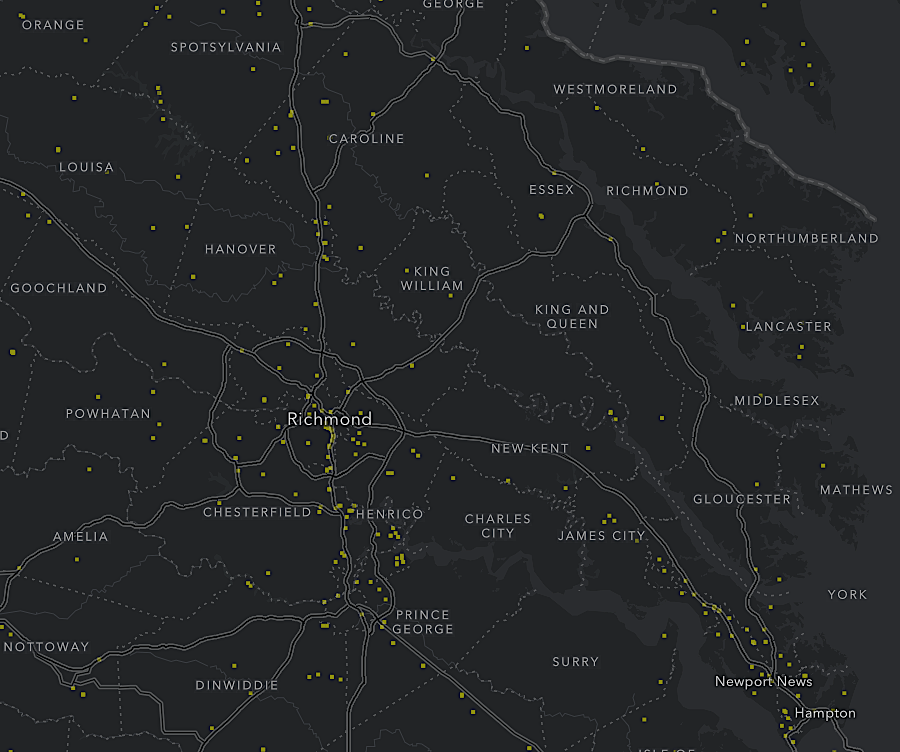
the lower demand for electricity on the Middle Peninsula and Northern Neck is reflected by the lower number of substations east of I-95
Source: Justice40 Initiative, Electric Vehicle Charging Justice40 Map
It is hard to store electricity in bulk other than in small batteries for cars and flashlights. With rare exceptions, including two giant pumped storage facilities in Virginia at Smith Mountain Lake and in Bath County, electricity in Virginia is used as it is generated.
Electricity is transmitted from the generation sites through a grid of high-voltage wires across the state to locations where customers need power. The 7,300 power plants in the United States are connected via nearly 160,000 miles of high-voltage power lines, and even more mileage of lower-voltage distribution lines, to 145 million customers.
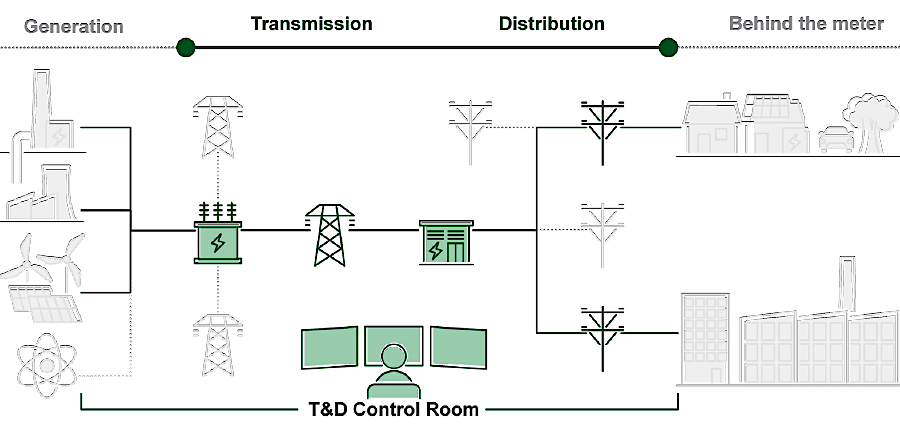
electricity generate at just a few locations goes through the transmission and distribution grid to millions of customers
Source: US Department of Energy, Pathways to Commercial Liftoff: Innovative Grid Deployment (Figure 1)
Alternating current (AC) is transmitted long distances at high voltages in order to reduce "line losses" associated with resistance and impedance.
At solar facilities which generate direct current, inverters and transformers modify the electricity to the appropriate AC voltage for distribution/transmission. While light bulbs in a house are powered by alternating current, electronic devices which use batteries are designed for direct current. Traditional lead-acid car batteries provide a 12-volt supply to power headlights, while flashlights operate off 1.5-volt batteries. Inverters allow a laptop battery to be charged from an outlet on a wall connected to the grip delivering alternating current. An inverter converts the alternating current coming from the grid to the outlet into the direct current used by a laptop.
There are some long-distance (greater than 350 miles) High Voltage Direct Current (HVDC) transmission lines in North America. Unlike the more-common alternating current transmission lines, High Voltage Direct Current lines deliver electricity from one point to another but no customers can tap in and obtain electricity between the endpoints.
In 2024, the first High Voltage Direct Current transmission lines in Virginia were installed between Virginia Beach and the Coastal Virginia Offshore Wind project. The offshore wind turbines generated direct current.
High Voltage Direct Current transmission is particularly suitable for long distance transmission underwater. It is more efficient than alternating current, and there are no intermediate substations with customers who require alternating current.
The Atlantic Wind Connection Project is a proposal to build an underwater, high voltage, direct current backbone transmission system carrying 7,000MW from offshore wind facilities located between northern New Jersey and southern Virginia. The Atlantic Offshore Wind Transmission Study explored connecting offshore wind farms between Maine and South Carolina. By 2050 they could generate 85-110 GW of electricity, and an offshore grip with multiple connections to the onshore grid would increase reliability.1
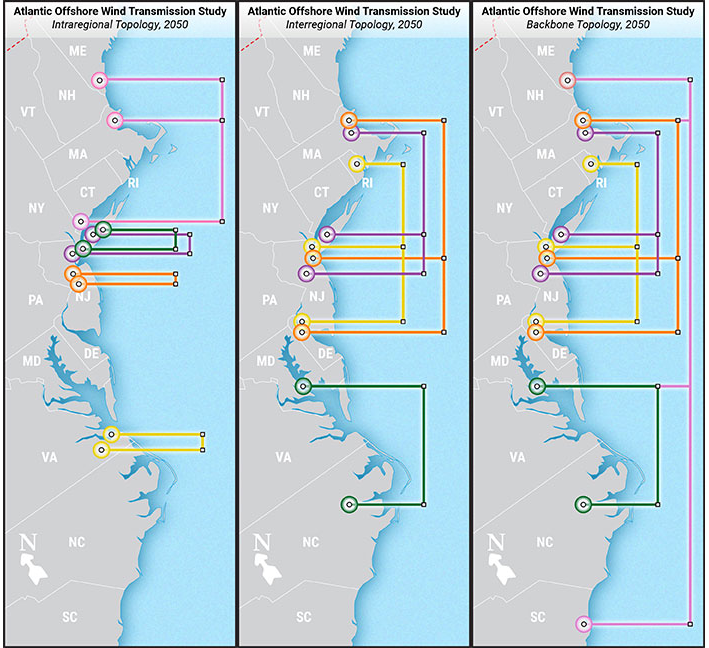
by 2050, offshore wind facilities between Maine-South Carolina could be generating 110 GW and be connected by an offshore grid
Source: US Department of Energy, National Renewable Energy Laboratory, Atlantic Offshore Wind Transmission Study
On all transmission towers, the electrical current is kept isolated by conductors. Conductors block a connection to the ground which would create a short circuit. Transformers and substations are expensive, but transmission at high voltage in more efficient because it reduces the loss of energy through resistance in the aluminum/steel wires.
Near the "load centers," transformers at substations step down the high-voltage in the transmission circuit (between 750kv-69kV) to distribution voltage (typically 35kV or lower). Near individual homes, transformers on power poles lower the voltage one final time. The wires from power poles to houses normally carry just 120-240 volts.
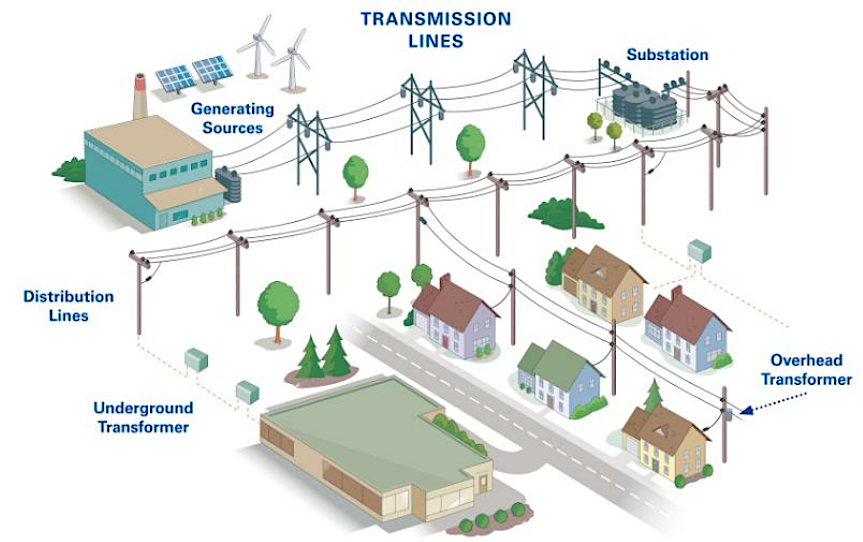
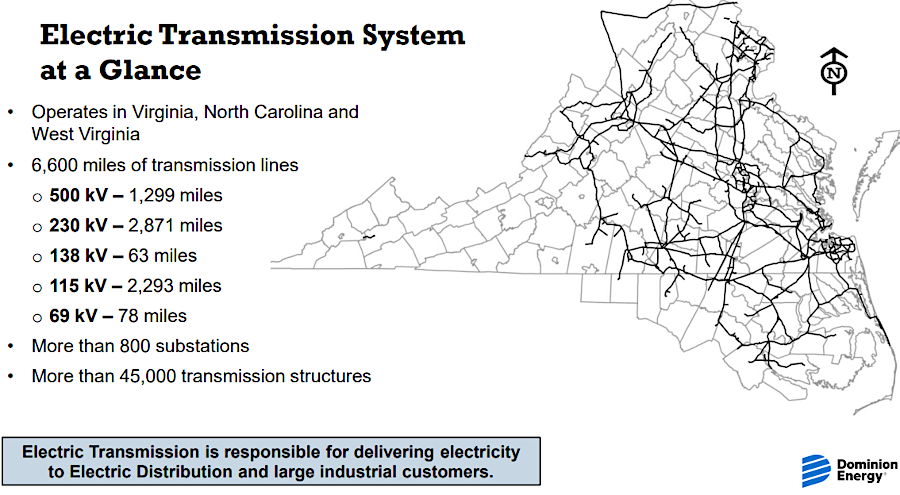
in 2018 the investor-owned utility Dominion Power managed 6,600 miles of transmission lines ranging from 500kV to 69kV
Source: Dominion Energy, Electricity Transmission Overview
Since the 1880's a transmission network of wires have connected nearly every house/business/factory to electricity generators fueled by water, coal, nuclear, biomass, solar, and other sources. Touch any power pole on any city street, and you will be connected through electricity transmission wires to almost every inhabited structure in North America.
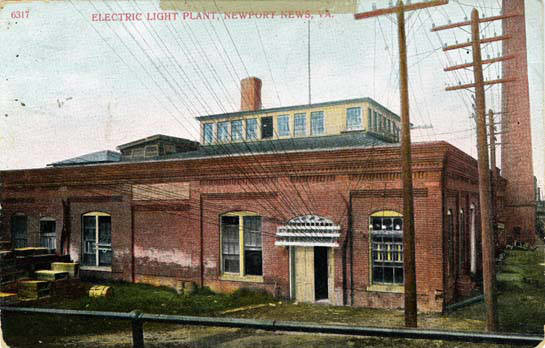
the Peninsula Electric Light and Power Company provided electricity to Newport News in 1913
Source: Newport News Public Library, Electric Light Plant (1913)
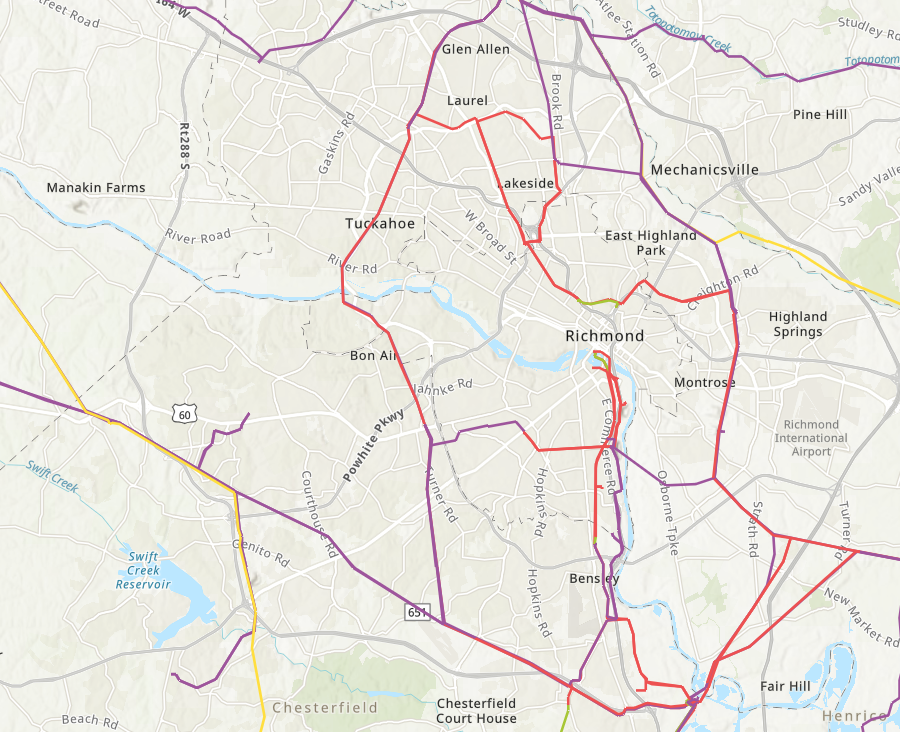
modern transmission lines around Richmond
Source: ESRI, ArcGIS Online
The location of mechanical energy at waterfalls shaped development of early manufacturing, so Virginia's first cities were located at the Fall Line. In contrast, electricity is portable. Today, factories, offices, houses, shopping centers, etc. can be located wherever a power line can reach. Electricity has enabled decentralized development.
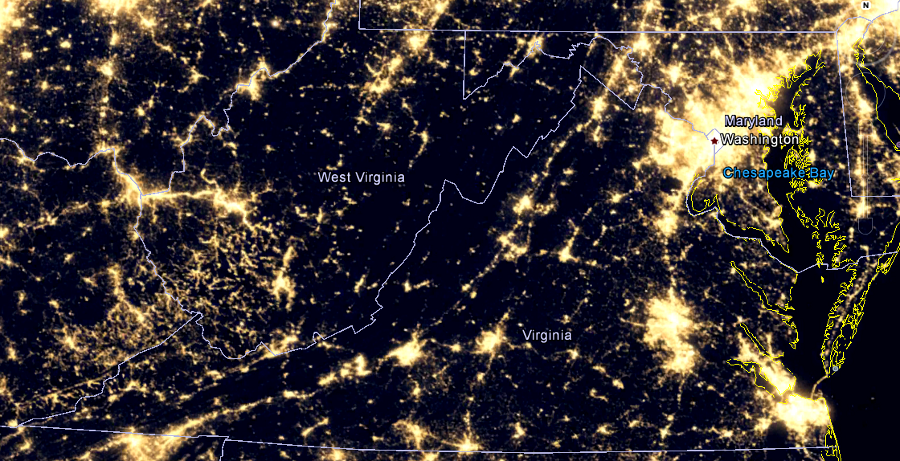
the pattern of urban development in Virginia would be even more concentrated if transmission of electricity was limited to just several miles from the generating facility
Source: NASA Earth Observatory, Earth at Night 2012
The impact of electricity could be replicated by a later technology. The Internet enables employees to work from home; telecommuting is altering the transportation patterns for getting to and from work. Investors now shape their purchase of stocks based in part on predictions that the distribution of goods and services will be revamped. Competition will result in some industries growing, while others such as newspapers will be shrinking.
A century earlier, the same apocalyptic predictions could have been made about the impact of electricity on cities.
After 1900, manufacturing locations decentralized away from the urban core as electricity enabled factories to obtain power in rural areas with lower-cost labor. Finance, government, and retail operations replaced manufacturing; downtowns became white-collar centers.
At the same time, the automobile enabled workers to commute to jobs from much further distances, and to live far away from rail/trolley lines too. New suburbs initiated suburban sprawl. In Northern Virginia, the population boom from government workers filled up Alexandria, Arlington, and the Fairfax counties as Federal agencies swelled to deal with World War I, the Depression, World War II, and then the Cold War. After the Shirley Highway reached the Occoquan River, developers created Dale City, Montclair, Lake Ridge, and other subdivisions in Prince William County and workers commuted 30 miles to jobs in the urban core.
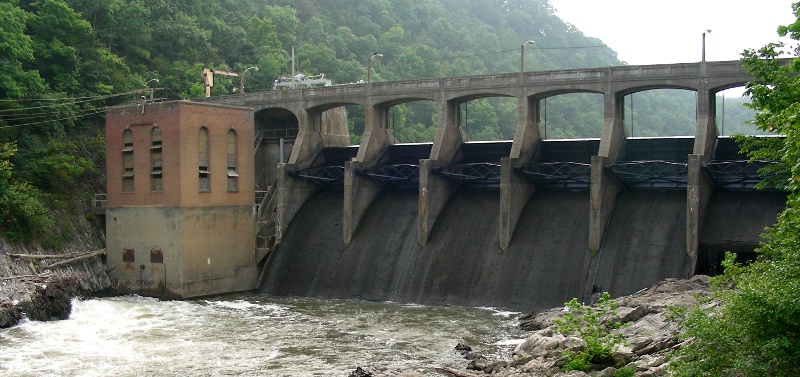
City of Radford has a 1-megawatt hydropower plant on the Little River, supplying roughly 1% of the city's demand
Getting electrical power to the homes of these decentralized residents required expanding the distribution system, as well as increasing the number of new power plants generating electricity. To minimize costs, the State Corporation Commission ended up regulating power companies, eliminating competition along with unsightly duplication of power poles.
Even with costs reduced through control of competition, investor-owned utilities could not justify the expense of spreading electricity into low-density rural areas. The Federal government financed delivery of power to many farms through the Rural Electrification Administration (REA), after the 1930 Census showed that only one tenth of American farms had access to electricity generated at facilities off the farm.2
The political arguments in favor of the rural electrification movement highlighted the benefits of Federal support. Tax dollars, coming primarily from urban areas, brought electricity to barns for electrical lights and milking machines, and to rural homes for refrigerators and washing machines. Of equal importance to the Federal government was the desire to stimulate economic development in the rural countryside, to support high-paying industrial jobs in factories located in the rural communities.
Industrial development transformed rural landscapes. The ability to bring electricity to wherever land prices were low has created conflicts with modern environmental concerns. The last remaining undisturbed habitats of threatened and endangered species are also potential sites for new factories and power plants.
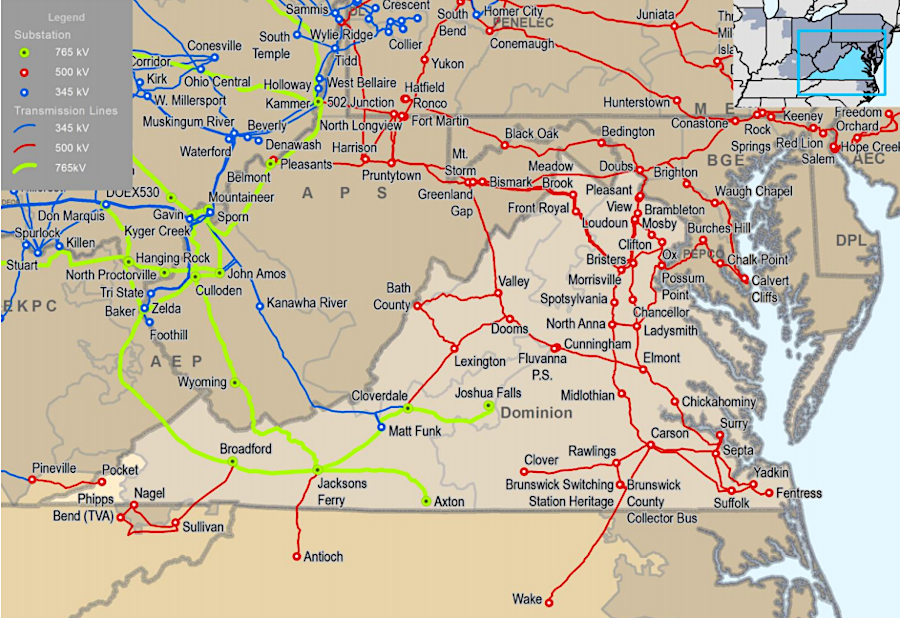
the 765kV transmission lines in Virginia are in the southwestern part of the state
Source: PJM, Virginia State Report (2017)
The National Rural Electric Cooperative Association is a member of a group called the National Endangered Species Act Reform Coalition. That coalition is still seeking to weaken environmental protections and increase the potential for more development in rural areas. The National Rural Electric Cooperative Association is located in the Ballston area of Arlington County. That is far from the rural areas served by the electrical cooperatives, but next to a Metrorail station that provides easy access to the US Congress and headquarters of key Federal agencies.3
The voltage of the electricity produced generators spinning at power plants is "stepped up" before being shipped out to customers as alternating current in 60-cycle phases, then "stepped down" at substations and ultimately transformers near our houses/stores/offices to become 220-volt or 110-volt circuits.
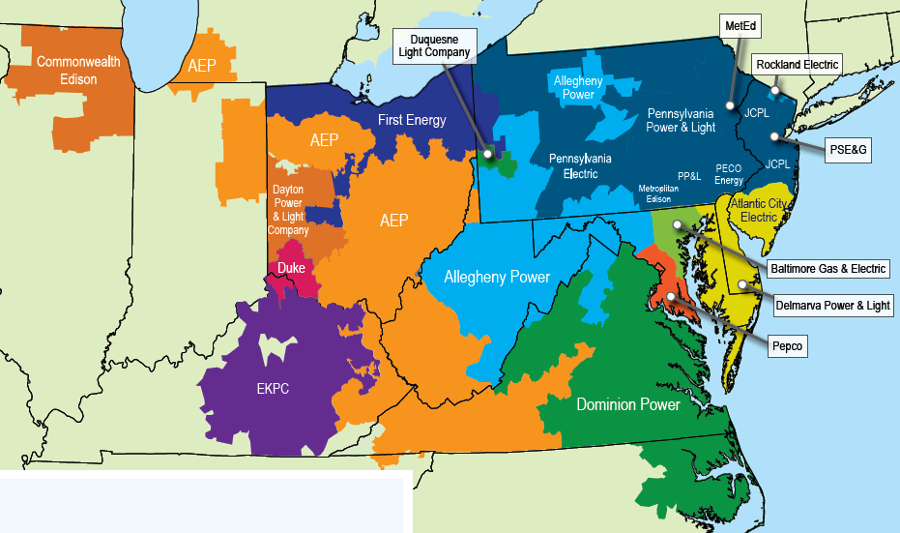
PJM is the Regional Transmission Operator and Independent System Operator that controls the dispatch and transmission of electricity across 13 states and the District of Columbia
Source: PJM, PJM At a Glance
Electrons do not move down the wires in one continuous flow directly from generators to houses. Waves of alternating current shift directions 60 times/second, based on the spinning of the generators. As a result, electrons oscillate back and forth just a short distance - roughly 1mm - within the wires, energizing motors and light bulbs. A connection to ground on either side of the circuit ensure the electrons can move 1mm beyond the wire's ends.
Though individual electrons move only a short distance, once a transmission line is energized the electrical current moves at essentially the speed of light (186,000 miles/second) to the other end of the wire. In a wire carrying one ampere (amp) of current, 6,241,000,000,000,000,000 electrons (one "coulomb") are flowing per second.
High-voltage transmission lines carry three-phase current. Three parallel wires transmit three alternating currents which reach their peak values at different times.4
Until recently, the grid was exposed as overhead wires attached to poles and towers. That network is unsightly, so in many modern subdivisions the "last mile" of wires between substations and houses have been buried underground. Burial of low-voltage distribution lines can be justified in areas with repeated outages. Buried wires are not disrupted by trees or ice storms. Burial has a high one-time costs, but increases service reliability, reduces the time to restore power, and minimizes continuing vegetation management and repair costs.
Dominion Energy started its Strategic Underground Program in 2014 to bury "tap lines" bringing power from substations to neighborhoods and individual houses. The first large-scale undergrounding program in the United States was created after Hurricane Irene in 2011 and a derecho in 2012 disrupted power to a million customers. The State Corporation Commission (SCC) has approved a special fee ("rider") paid by all customers to fund the Strategic Underground Program investment. There is a limit on the cost per mile for undergrounding projects, so the costs are consistent with benefits.
The lines most prone to outage over a 10-year period have been prioritized for undergrounding. The company determined that 20% of their distribution lines experienced 2/3 of the outages, and burying lines successfully reduced the total length of restoration time by 25%. The objective set by Dominion Energy was to convert 4,000 miles of tap lines from overhead to buried lines.
By 2025, Dominion Energy had buried 2,500 miles of line. That was 13% of the tap line network statewide, and average outage time had dropped from 11 hours to two minutes. As described by a company representative:5
Source: Dominion Energy, Dominion Energy Strategic Underground
High-voltage wires generate substantially more heat than low-voltage distribution lines. On overhead lines, wires are spaced far enough apart so the air cools them. High-voltage wires can be placed in trenches and ducts underground, but must be separated to avoid overheating. Obtaining adequate separation distance requires digging wide and/or deep trenches. Even where Horizontal Directional Drilling is used rather than open trenching, excavation can disrupt roads and other existing infrastructure.
Because the cost to bury high-voltage transmission lines is dramatically higher, they have been placed underground in only a few places. A 3.7 mile line in Arlington County was one of the first to be buried by Dominion Energy.
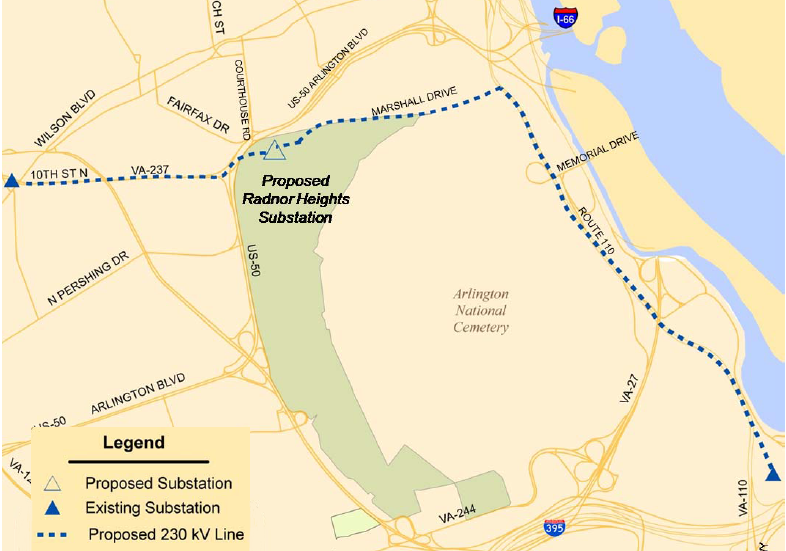
buried 230kv transmission line in Arlington
Source: Dominion, Radnor Heights 230 kV Underground Transmission Lines and Substation, Project Fact Sheet
The State Corporation Commission has ruled that a 230-kilovolt cable should be buried for 5 miles between Aquia Harbor and Garrisonville in Stafford County. An overhead line would cost $14.14 million, while the buried cable would cost $82.3 million. Burying the line was nearly 500% more expensive than an overhead line, but it protected the scenic view (and local home property values) for a 5-mile stretch. To cover those costs, all of Dominion Virginia Power's customers will pay an extra $0.10/month in their electrical bills to repay the extra $68 million required for line burial.6
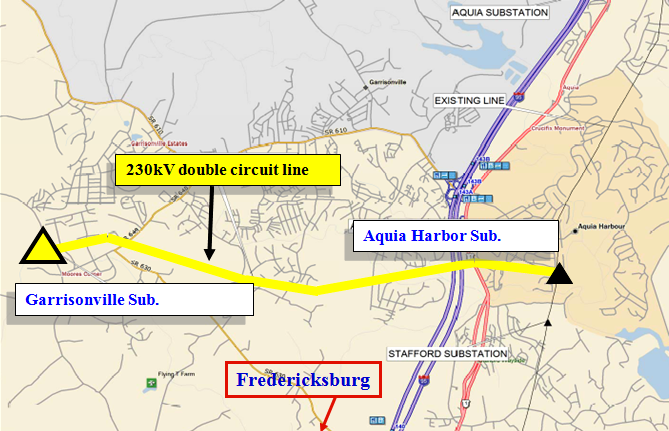
buried 230kv transmission line between Aquia Harbor-Garrisonville
Source: Dominion, Underground Transmission Lines at Dominion Virginia Power
Because electricity is generated at central power plants while the product is very decentralized, transmission from the "factory" to the customer requires a distribution system. Overhead wires connect nearly every occupied building in Virginia to each other today.
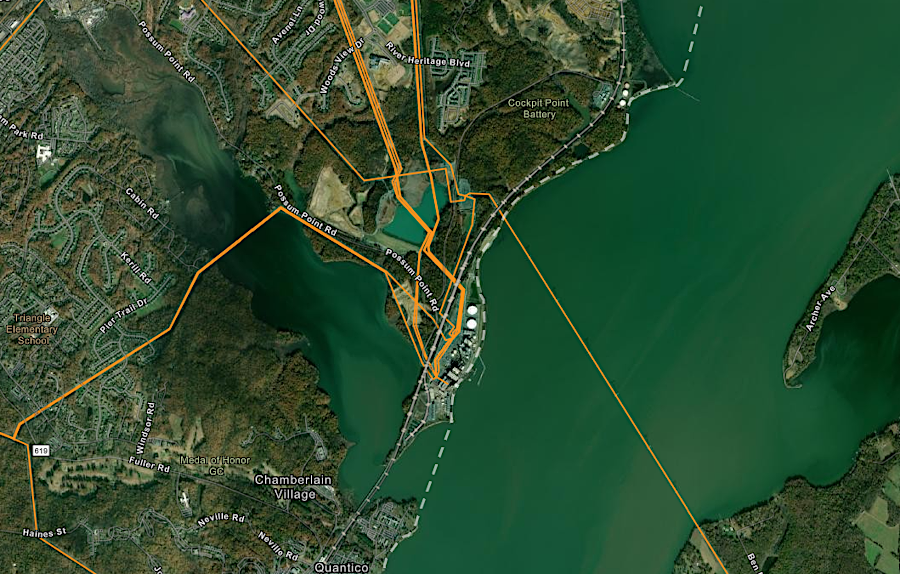
Possum Point is key node for transmission in Prince William County, with a 500kV line crossing the Potomac River to Maryland
Source: Homeland Infrastructure Foundation-Level Data (HIFLD), Electric Power Transmission Lines
The state road network is comparable to the electrical grid, with connections to service nearly every house. The public road infrastructure stops at the edge of the property lines, and driveways on private property are constructed/maintained by private property owners.
Water and sewer pipes stop at the edge of private property. If there is a clog in the pipe that goes underneath the lawn between a water meter and a house, clearing the pipe is the responsibility of the private property owner. Of course, all pipes inside the house are also the responsibility of the homeowner. Rural residents who depend on individual wells and septic systems, for houses not connected to the water/sewer network of pipes, are responsible for 100% of their infrastructure.
The character of the telecommunications network is similar to the electricity network as well, though wires for broadband were not extended far into sparsely settled areas until after the 2019 COVID pandemic. Efforts to extend broadband internet service to every house may not require extending a wire to every house; cell towers and satellite connections may be solutions without wires.
The electricity transmission infrastructure follows a slightly different pattern. Utilities or electric co-ops obtain legal easements which authorize wires to cross private property. The wires, owned by the utility or co-op, go from the nearest transformer on the electricity distribution system and cross that easement. The utility or co-op's wires bring electricity directly to a meter on a building.
The owner of the building is responsible for all the wiring leading from the outside meter to a main panel inside the building. Wires from that main panel distribute electricity to separate circuits inside the building. A homeowner who builds an addition and needs to expand the panel or add subpanels, or has problems with wiring and outlets inside the building, must pay for any assistance needed from electricians. However, if a tree falls on the wire bringing electricity from the transformer to the meter, the utility or co-op will send a crew to re-establish the connection.
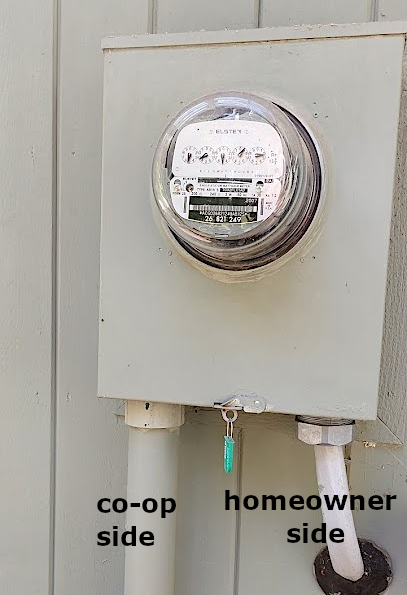
the public electricity transmission network stops at the utility's meter on a house
Without the electricity transmission system, most factories would need to be located near power plants. Imagine a world where power could not be transmitted by wire... would houses also be located near power plants? Perhaps modern urban development would be concentrated around waterfalls, and in southwestern Virginia near the coal fields - or we would have installed solar power units on every rooftop, and diesel generators in every garage.
If electricity could be generated at the same location it was used, perhaps via solar panels on rooftops, then rural areas would not need to maintain long stretches of power lines for a small number of customers. In the future, shrinkage of the electrical transmission system might be the opposite of the shrinkage of the telecommunications system, with rural areas dropping connections first. The Amish in Giles County are a model. They choose to generate their electricity at their homes and stores, rather than connect to the grid.7

furnace burning coal to produce steam and electricity at Virginia Tech co-generation plant
In the near future, most electricity will be generated by wind energy, methane from landfills, co-generation at factories, and solar panels rather than at centralized gas-fired and nuclear power plants. Renewable energy sources will be widely distributed in 2040, compared to the centralized transmission network in 2020.
Some renewable energy sources could still be centralized energy sources. Wind energy generation will be concentrated at a few windfarms on mountain ridges and offshore, and large solar facilities will generate electricity for thousands of buildings. To transmit electricity from those new sources to customers, the National Rural Electric Cooperative Association claims:8
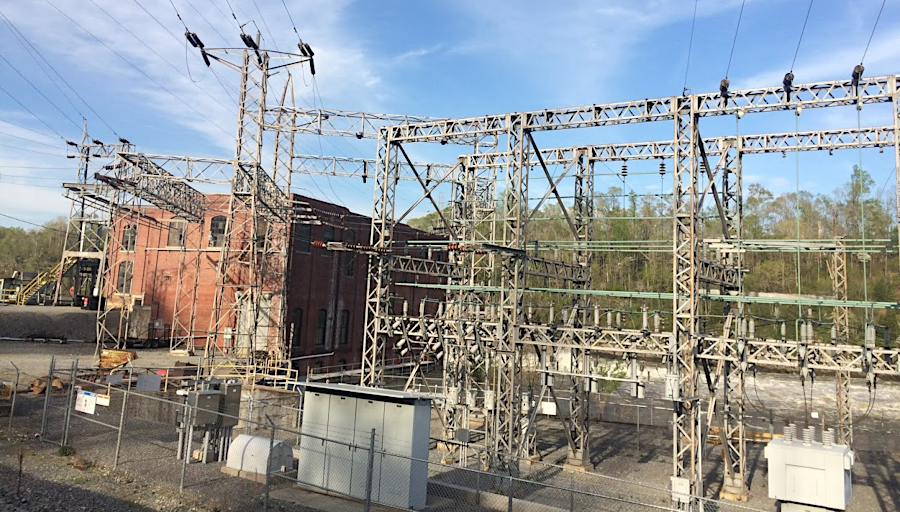
the Reusens hydropower facility near Lynchburg ships electricity by wire to customers
There are complex electrical engineering factors that affect the management of the grid of power lines that connect suppliers with customers. In bulk power transmission, the voltage and the phase transmitted from the "sources" to the "sinks" must be balanced. In the "good ol' days" for the last 80 years, utilities have been regulated so generation, transmission, distribution, and billing for electricity use was consolidated in one company for a specific geographic area. In return for a monopoly control on providing electricity and a commitment to service all customers, the State Corporation Commission regulated electricity rates so Virginia utilities earned a steady profit.
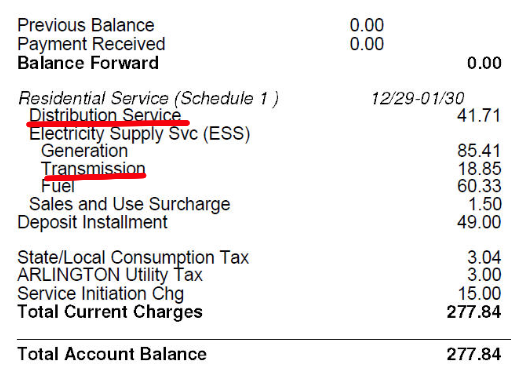
Dominion's electricity bills detail charges for local distribution separate from charges for long-distance transmission
Source: Reddit, Electricity bill -- am I getting screwed?
In 1952, state regulation was not adequate to ensure the private Virginia Electric and Power Company (VEPCO, now known as Dominion) would transmit electricity that it did not generate. After the US Army Corps of Engineers built the John H. Kerr Dam on the Roanoke River, the Federal government wanted to transmit its low-cost, hydropower-generated electricity to the Air Force base at Langley.
VEPCO refused to allow the Federal government to use its transmission network. There was an intense public policy debate at the time over the role of the Federal government in the licensing of private dams on public rivers, and in the marketing of hydropower from public dams.
VEPCO hoped to force the government to sell its power directly to the private utility, which could then re-sell the low-cost electricity at a substantial profit. An Alabama utility had re-sold electricity produced at a Corps of Engineers dam on the Tennessee River for twice its purchase costs, and the Corps was unable to generate enough revenue to repay the initial Federal capital investment. The failure of the Corps to negotiate a better price for its power helped spur the replacement of that agency with the Tennessee Valley Authority (TVA).
The US Congress responded to VEPCO's intransigence with a commitment to fund a new 146-mile long transmission system between the power plant and the military base. At that point, VEPCO negotiated a price for transmission, and allowed other "preference customers" (electric cooperatives and municipal utilities) to connect in order to obtain access the public power.
Only in 1996 did the Federal Energy Regulatory Commission (FERC) mandate, through the Open Access Transmission Tariff, that utilities must transmit power generated by others. In 2005 a regional "neutral" organization - The PJM Interconnection (P=Pennsylvania J=New Jersey M=Maryland) - took responsibility for managing electrical transmission on Dominion Power's network.
In 2020, PJM managed transmission from all but one of the 212 electricity generating facilities in Virginia with planned connections to the grid. The one exception was the Bristol landfill, which dispatched its electricity through the Tennessee Valley Authority (TVA).9
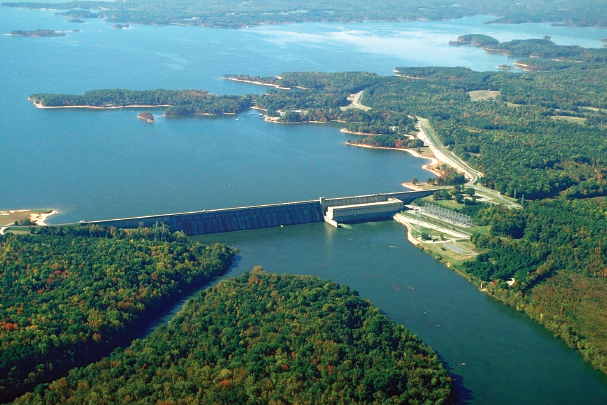
low-cost power generated at Kerr Dam is transmitted across southeastern Virginia to the Langley Air Force Base
Source: Serving The Southeast: History Of The Southeastern Power Administration 1990-2010 (p.13)

in the 1950's, private utilities tried to block distribution (wheeling) of hydropower generated at the new Kerr Dam to competing utilities, including electric cooperatives
Source: Serving The Southeast: History Of The Southeastern Power Administration 1990-2010 (p.13)
With deregulation of the utility industry, the number of suppliers, marketers, and purchasers of power is far greater and the accounting for power transmissions is far more complex. When a power plant goes off-line or a solar flare disrupts transmissions, the grid's ability to move power from source to sink at the correct voltage is affected. PJM reduces voltage 5% to cope with excessive load demands.10
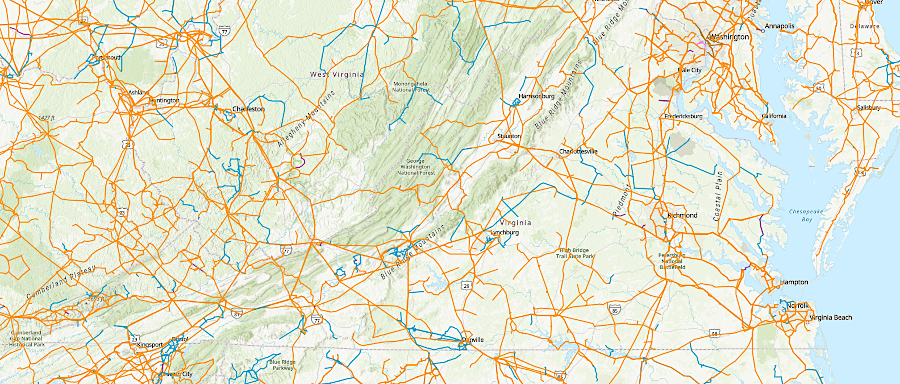
through the PJM grid, Virginia can import or export electricity though high-voltage transmission lines
Source: Homeland Infrastructure Foundation-Level Data (HIFLD), Electric Power Transmission Lines
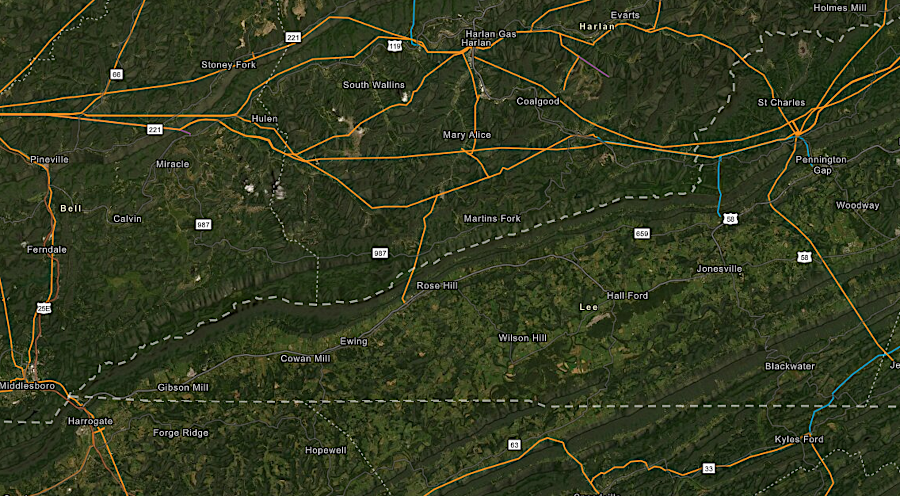
demand for electricity in the sparsely-populated southwestern tip of Virginia is met using distribution lines with voltage lower than 69kV
Source: Homeland Infrastructure Foundation-Level Data (HIFLD), Electric Power Transmission Lines
Electricity delivery is not as straightforward as the delivery of mail by the Postal Service or packages by FedEx/UPS. The transmission lines (the wires on the tall towers crossing the countryside) transport electricity. As population grows and people use more electrical appliances in the home, demand for electricity is rising. New "electricity highways" are constructed by adding new wires to existing towers, or occasionally constructing a new set of towers. Such construction can be politically difficult; few people consider transmission lines to be esthetic, and some question the safety of living near them.
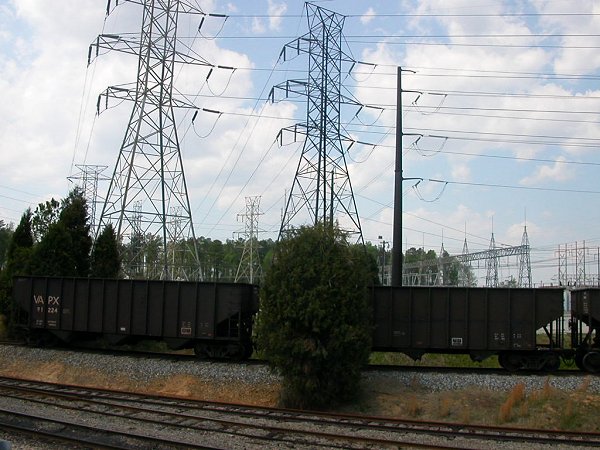
moving energy, from coal hopper cars to high-voltage transmission lines at Chesterfield power plant
Virginia Power purchased the rights-of-way of the failing Washington and Old Dominion Railroad in the early 1960's, to acquire a corridor for a new transmission line to supply the growing Northern Virginia region. Only after some contentious discussions was the route also made into a bike trail for recreational use. American Electric Power (AEP) built a 765 kilovolt power line from its coal-fired power plant in Wyoming, West Virginia to Jacksons Ferry Station near Wytheville/ Pulaski, but required 13 years to obtain approval and build the connection.11
Virginia utilities buy bulk power via the largest interconnected, managed grid of transmission lines in the United States, PJM Interconnection (PJM Interconnection (P=Pennsylvania - J=New Jersey - M=Maryland)). A small section of the state, the Eastern Shore, is supplied directly by a PJM member (Delmarva Power & Light).
Electricity is bought and sold for firm delivery under long-term contracts and on a "spot" market to meet short-term demand. When Virginia Power acquires electricity from the New York Power Pool, the capacity to transmit the energy through Pennsylvania and Maryland transmission lines must be reserved along with the power itself. Since PJM Interconnection is a multi-state operation, the procedures and prices are affected by a Federal Energy Regulatory Commission (FERC) tariffs. Arrangements for delivery are handled in part through an online system, OASIS.
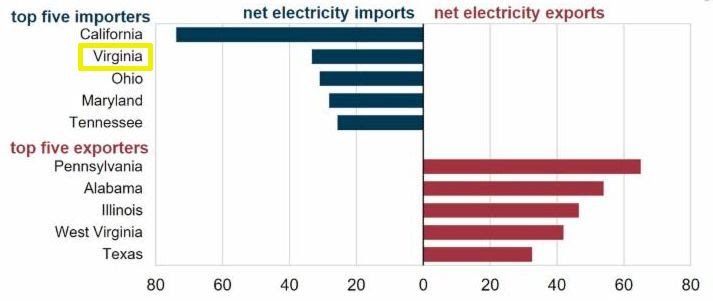
Virginia is second only to California in import of electricity, measured in million megawatthours (MWh)
Source: Energy Information Administration, Today in Energy: California imports the most electricity from other states; Pennsylvania exports the most (April 4, 2019)
Virginia is included in two regions of the North American Electricity Reliability Council. Most of the state is associated with the SERC Reliability Corporation (SERC). The region served by American Electric Power (AEP), with most of its power plants in the Ohio River watershed, is associated with ReliabilityFirst.
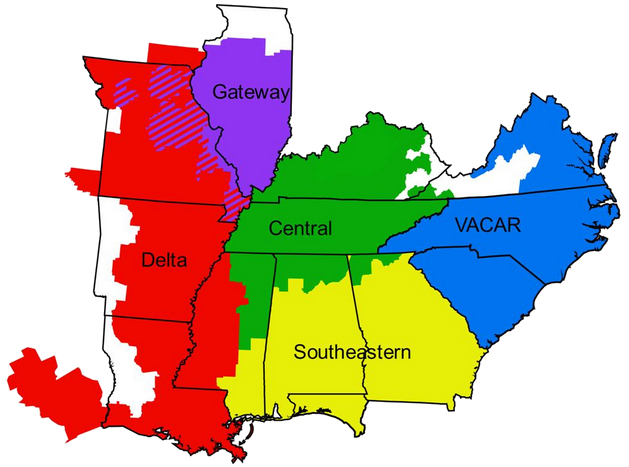
Appalachian Electric Power (AEP) in the ReliabilityFirst district, while the rest of the state is associated with the SERC Reliability Corporation (colored blue)
Source: SERC Reliability Corporation, sub-regional boundaries map
Production of electricity is highly centralized. The economies of scale lead to large hydroelectric dams and coal-fired power plants and nuclear reactors, rather than numerous small ones. The Public Utility Regulatory Policies Act of 1978 ("PURPA") encouraged a shift to decentralized production of electricity (and steam). This was a side effect - primary emphasis of the legislation was to stimulate production from non-traditional, renewable sources.
The ongoing deregulation of electricity is likely to increase the number of electricity producers, spurring co-generation at many manufacturing facilities. From a geographical perspective, the current map of sites in Virginia creating electricity for sale is likely to have many more dots in the future.
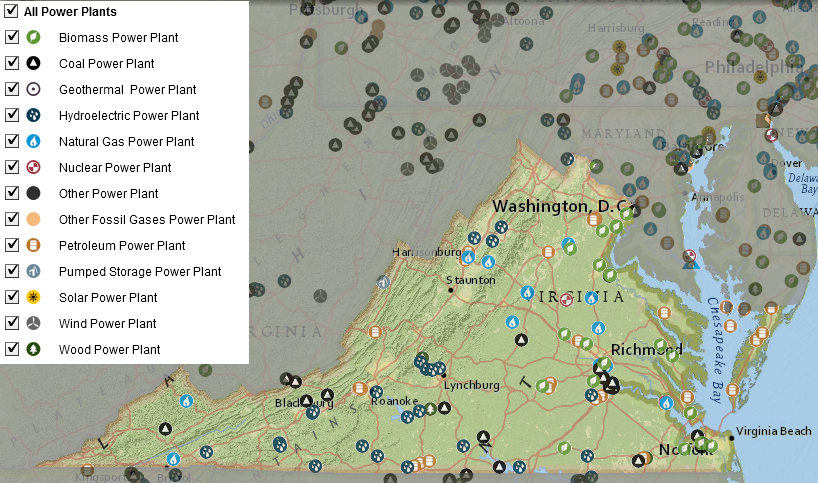
places where electricity is generated for commercial use in Virginia
Source: US Energy Information Administration, Profile Overview
Traditionally, it is wiser to put a few eggs in many different baskets rather all eggs in one basket. According to that approach, creation of more power plants in Virginia should increase our energy security. Initially, every Virginia manufacturing facility created its own independent power from wood or water. If a water wheel or dam broke for one grist mill, other mills could continue operating.
Urban centers started to create electricity in a similar fashion. When Richmond established the first hydroelectric plant to power street cars, or when Manassas created its own hydroelectric plant on Bull Run, the cities built stand-alone systems unconnected to any other sources of power. If ice clogged the intakes in January, Manassas customers froze in the dark for a few days - or relied upon their wood stoves and kerosene lamps. When these and other plants were connected by a grid of transmission lines, however, it became less likely that failure/sabotage at one large facility could blackout a significant region of Virginia.
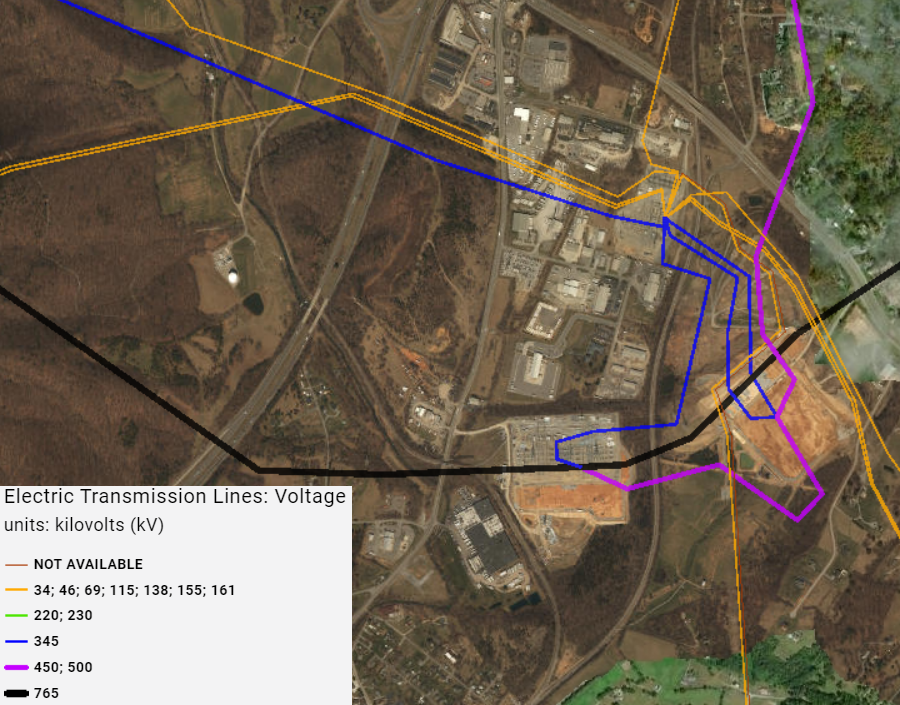
transmission lines connect at substations in places like Cloverdale, north of Roanoke
Source: Mid-Atlantic Regional Council on the Ocean, MidAtlantic Ocean Data Portal
Major utilities rely upon just a few major generating sources to supply nearly 7 million Virginian customers. A handful of nuclear and coal plants supply a steady base load of power 24 hours/day, while more-flexible natural gas and hydro plants can generate peaks of power for the surges in demand on weekday mornings and early evenings. The small PURPA-stimulated facilities, such as the waste-to-energy plant (incinerator) at the Lorton landfill in Fairfax County, are less-stable suppliers of power compared to the large centralized plants such as the Clover coal-fired plant in Halifax County.
Solar and wind facilities generate electricity, but offer less support for maintaining the grid. Turbines at hydroelectric, nuclear, and fossil fuel plants continue to spin during a blackout. The mechanical inertia from those turbines help compensate for sudden changes in the balance of generation and load. Solar and wind facilities lack turbines, and grid reliability is lowered as the percentage of renewable energy sources increases. One way to enhance grid stability and reduce the chance of a blackout is to enhance connections between separate grids, so power can be shared when a large generation trips offline.

electricity generated offshore will be transmitted via cable to the onshore grid
Source: US Department of Energy, Top 10 Things You Didn’t Know About Offshore Wind Energy (August 30, 2021)
The energy security provided through PURPA comes more from reducing the demand for imported oil than from adding more eggs to the basket. Adding up all the small generators, it would still be difficult to replace the megawatts of electricity generated at Surry 1 and 2. Even with the flexibility of the power grid, all Virginians have experienced temporary power failures.
There is even a threat of massive, nationwide failure of the electrical transmission system if the sun burps and emits a coronal mass ejection. A large solar eruption, comparable to the "Carrington event" in 1859, could induce excessive direct current in the transmission lines and burn out the transformers before circuit breakers trip. The igneous and metamorphic rocks in the Appalachian Mountains of Virginia would create the highest geoelectric amplitude hazard, in an intense magnetic storm, to the power grid system on the East Coast.12
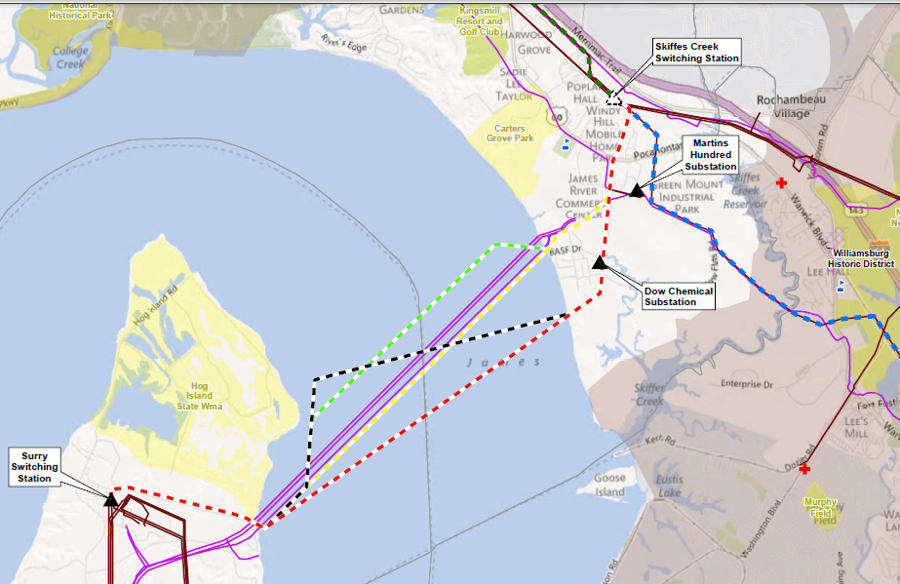
Dominion's proposal to build new power lines from the Surry nuclear plant across the James River triggered opposition due to impacts on the historic river view
Source: State Corporation Commission, Skiffles Creek Project Maps
Were it not for a sophisticated transmission system able to transfer power from suppliers are far away as Ontario and to adapt to drops/surges as plants change their production, we would not be able to assume the lights will come on when we throw the switch. The design of the Internet provides an interesting comparison.
The initial ARPANET design was intended to provide "survivability" for Department of Defense communications, even if major communications centers were obliterated by a nuclear attack. Instead of relying upon a few centralized switching centers, the Internet was designed to rely upon alternative routes in an interconnected grid of telecommunications networks. Of course, the costs of building transmission lines for electricity are far greater than the costs for transmission on Internet Protocol packets - and unsightly too. New power lines will not be constructed as fast as microwave towers are erected or fiber optic lines are buried underground, especially in Northern Virginia.
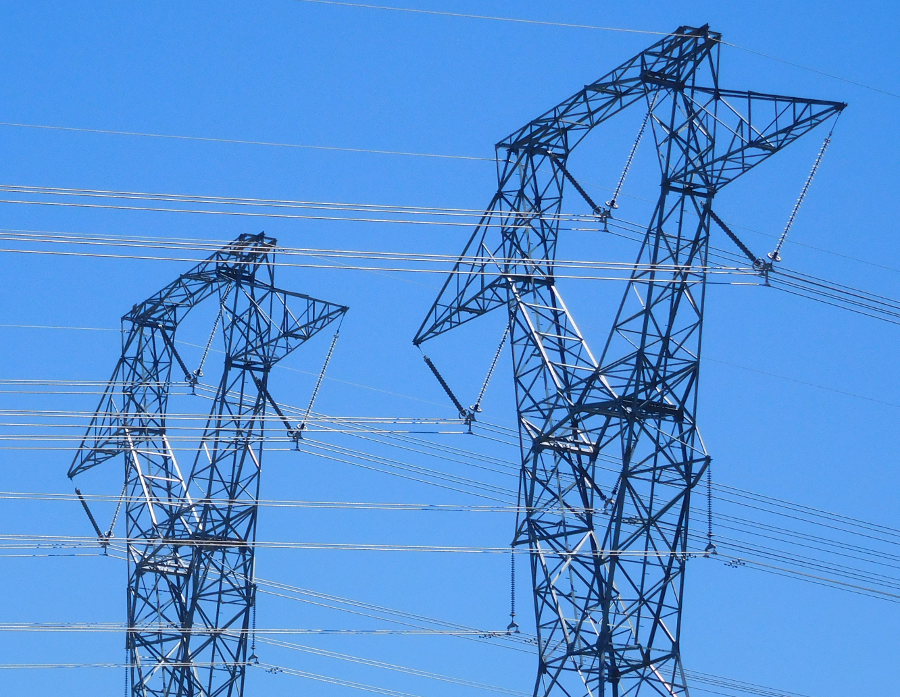
high voltage power lines transmit electricity via tall towers with wide rights-of-way
New energy sources are added now at the edge of the grid, at the margin rather than at the center of the distribution network. When developing a modern Local Area Network or Wide Area Network, new router/switch technology is installed first at the center, upgrading the key nodes of the network to achieve the greatest bang for the buck. As the technology ages, those routers/switches are displaced by "newer" hardware and moved to the periphery of the network. It is not uncommon for a high-end piece of hardware to migrate from a key transmission node in the core to an isolated status as an end-user desktop computer in a period of just months. Power plants, in contrast, have life cycles measured in decades.
One other comparison illustrates the geography of electricity in Virginia - the highway network throughout the state. It was designed initially to get crops from farms to market, and is now used to get manufactured goods to market (i.e., trucks on I-81 and the Woodrow Wilson Bridge) and employees from home to work. In hilly areas such as Buchanan County, a blockage of one road will dramatically interfere with local transportation. In other areas, such as Shenandoah County, there are many alternative roads that will allow drivers to reach their destination without waiting for the blockage to be cleared.
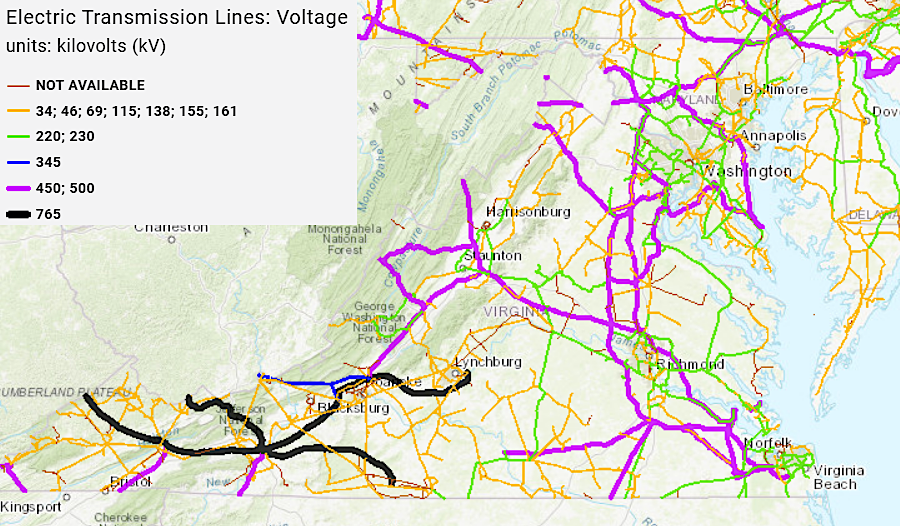
transmission lines of different voltages cross Virginia
Source: Mid-Atlantic Regional Council on the Ocean, MidAtlantic Ocean Data Portal
Public investment in mass transit increases dependence upon centralized systems, reducing flexibility to adapt to changing situations. Highway bridges and tunnels in particular are weak points, comparable to the interties connecting different electrical grids. Radio stations provide highway traffic reports "on the eights" or "every ten minutes," indicate the dependence on just a few routes for navigating the urban centers in Virginia.
In places such as Arlington County and Hampton, local roads provide multiple choices for local traffic, but the limited backbone of Interstate and arterial highways is highly vulnerable to disruption. One accident can make 150,000 people late to work. There are now Internet traffic reports. The day may come when electricity transmission reports are commonplace on the radio.
Transmission congestion has delayed the development of solar projects in Virginia and wind projects in other states. Analyses for new electricity generation facilities include calculation of estimated cost for expanding transmission lines to carry the extra load. In some cases, the cost of transmission capacity equaled the cost to construct the solar panels or wind turbines, projects were dropped after discovering the cost of transmission, and analyses for other projects needed to be updated to assess how congestion would be relieved or shifted.
By 2021, the number of new proposed projects exceeded the capacity of regional transmission organizations and independent system operators to approve proposed interconnections to the grid. Companies had enough proposed solar, wind, and battery projects to meet 80 percent of the total demand for electricity in the United States. The time for completing the reviews for interconnection projects grew from 18 months to over 40 months, delaying the closure of power plants using fossil fuels and increasing greenhouse gas emissions.
The Federal Energy Regulatory Commission and the industry sought to revise policies and weed out the interconnection burden for speculative projects. In 2022 PJM proposed freezing review of all new proposals until 2025 because:13
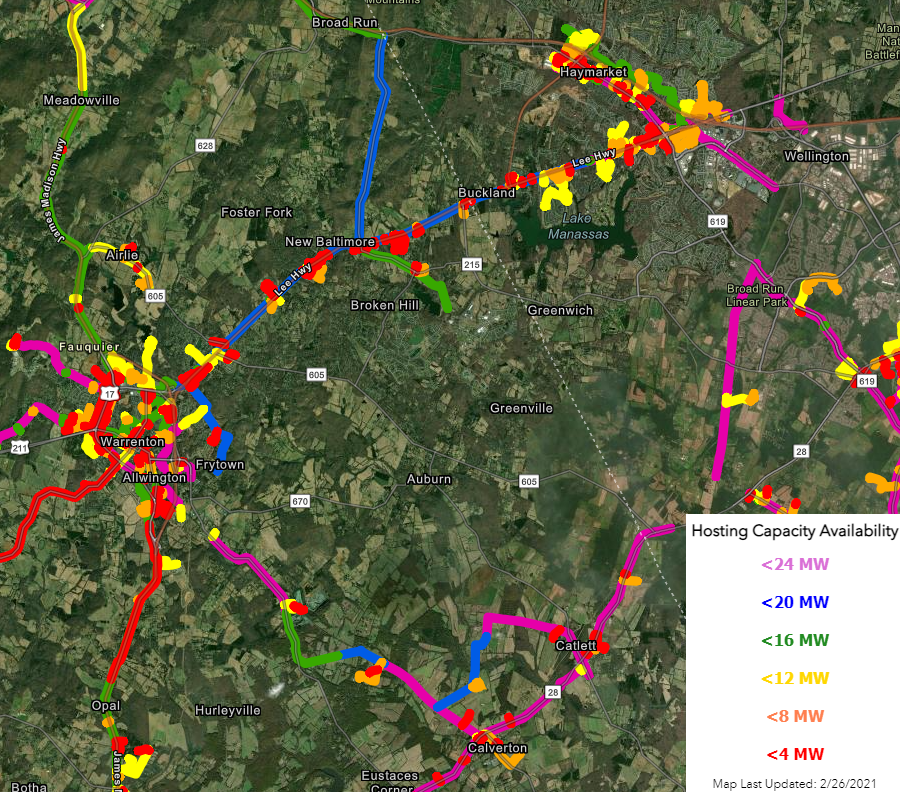
Dominion Energy has excess transmission capacity that varies in different areas, and no excess capacity in places without a line on the map
Source: Dominion Energy, Hosting Capacity Tool
Matching an increase in grid transmission capacity and generation capacity was complicated by the different state and Federal responsibilities for regulating utilities. Outside of Texas, Hawaii, Alaska, and the island territories such as Puerto Rico, there were overlapping responsibilities between state regulatory bodies (such as the State Corporation Commission in Virginia), Regional Transmission Organizations, Independent System Operators, and the Federal Energy Regulatory Commission (FERC). They authorized or rejected investments by utilities and other companies to ensure non-discriminatory access to transmission.
Typically, companies responsible for transmission were authorized to make a profit based upon the amount of infrastructure that required capital investment. There were fewer incentives to invest in increasing the efficiency of existing infrastructure with grid enhancing technologies, such as devices to measure the temperature of transmission lines so the amperage could be maximized. Greater efficiency would reduce the costs of transmission and benefit the general public, but would not increase the profits of the companies who owned transmission lines.
Building new transmission lines, or retrofitting old lines with new insulators and wires, requires years of planning, permitting, and construction. Because extra transmission (or storage) capacity could not be added fast enough, approval of major new wind and solar facilities was blocked during the administration of President Joe Biden. His Department of Energy advocated for increasing the supply of renewable energy, but the engineering, rights-of-way, and administrative processes for increasing transmission capacity to customers delayed interconnection to the grid. Some solar and wind facilities experienced orders to stop generation temporarily, because there was no capacity remaining in the grid to transfer that electricity to distant customers.
One observer concluded that the current process for approving new capacity revealed a fundamebntal:14
Changes in the location and types of generating plant are easy to understand, compared to the hard-to-see changes in the electrical distribution system. Deregulation of production, together with the inflexibility of the grid, will lead to public policy debates on ensuring fair access to the grid.
The Code of Virginia calls for jurisdictions to include planned transmission corridors in long-range Comprehensive Plans:15
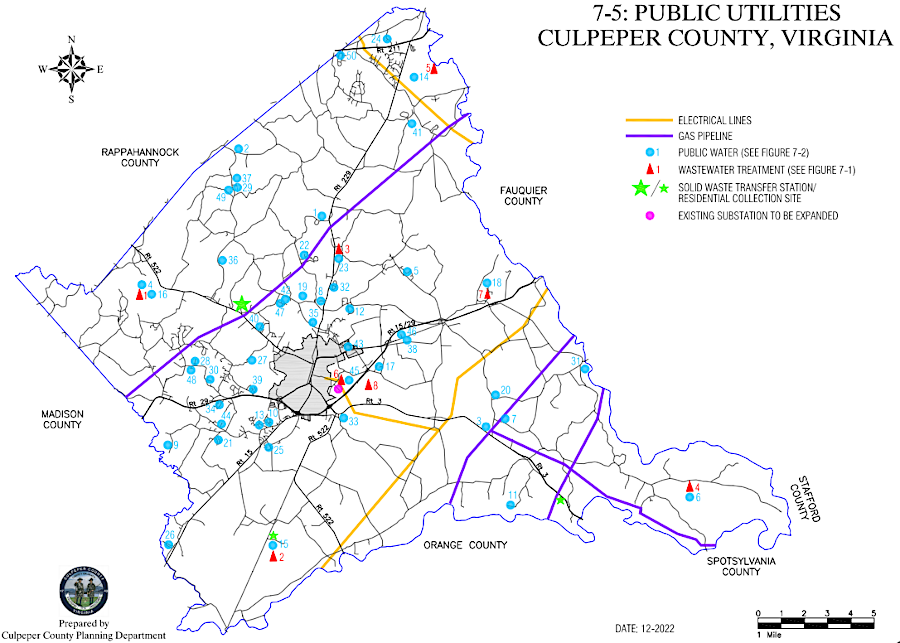
in 2023, Culpeper County's long-range Comprehensive Plan identified corridors for high-voltage electricity transmission lines
Source: Culpeper County, Comprehensive Plan - Chapter 7 - Utilities
Mapping such corridors would allow residents to know where the viewshed is expected to be impacted. However, the State Corporation Commission (SCC) is the state agency that makes the decision on where to route a new high-voltage transmission line. It must issue a Certificate of Public Convenience and Necessity (CPCN) for transmission lines carrying 115kV or higher, ensuring infrastructure investments by a regulated investor-owned utility are fair before requiring ratepayers to cover the costs. Lower cost distribution lines do not go through any State Corporation Commission review/approval process.
The State Corporation Commission assesses the costs of alternative routes. The three judges on that state commission may approve a low-cost route with relatively high socio-economic impacts, rather than authorize a more-expensive route that would mitigate those impacts, in order to minimize costs to ratepayers.
The State Corporation Commission will consider preferences of local jurisdictions, expressed in Comprehensive Plans, but local jurisdictions lack the power to authorize or prohibit a particular route. The land use power of local jurisdictions might allow county supervisors, city councils, and town councils to control the location of substations, but not the location of high-voltage transmission lines.
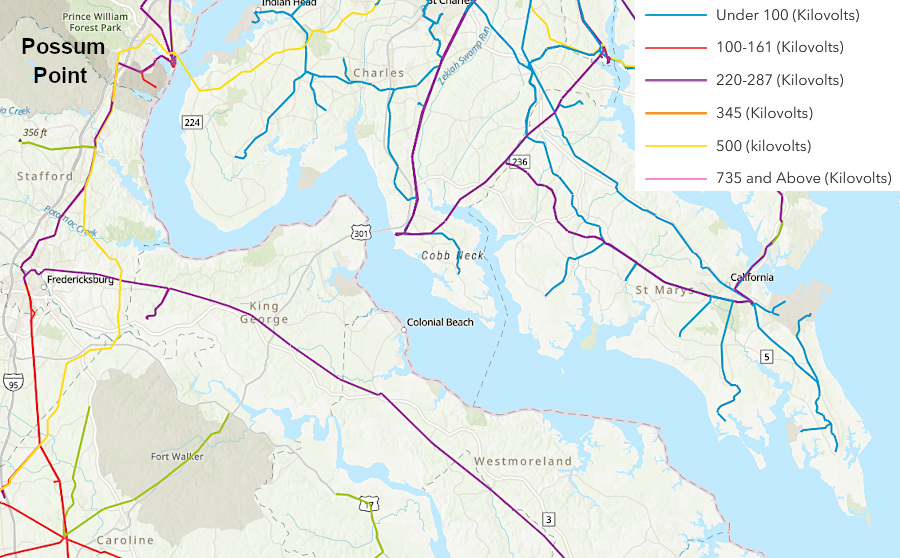
downstream from Possum Point in Prince William County, Maryland and Virginia grids are not connected
Source: ESRI, ArcGIS Online
In Northern Virginia, a surge in plans for building new data centers after 2020 led to a political upheaval. The incumbent chair of the Prince William Board of County Supervisors was defeated in the Democratic primary in 2023.
Prince William County voters were upset at how close the new data centers were being planned next to residential subdivisions and national parks. The voters were also aware that new high-voltage power lines would have to be carved through the already-developed area, based on an experience years earlier when a new powerline to service a new Amazon data center was proposed through the Town of Haymarket.
To prevent a repeat of that experience, the Comprehensive Plan in Prince William County was revised to define a Data Center Opportunity Zone Overlay District. In 2022, however, the county supervisors approve new sites for data centers outside of that district.
When the chair of the Board of County Supervisors endorsed locating new data centers outside the Data Center Opportunity Zone Overlay District, including on parcels adjacent to Manassas National Battlefield Park, residents were savvy enough to understand that new 230kv and potentially 500kV powerlines would be required. Existing houses would be impacted by unplanned 100-foot wide rights-of-way and towers 100 feet high. The Electric Utilities Service Plan chapter in the new 2040 Comprehensive Plan had been revised at the same time, but the supervisors made no changes to indicate the county's preferred location for any of the new high voltage transmission corridors that would be required to deliver electricity to the new data center locations.
The public opposition to the proposed new data centers and future transmission lines led to the defeat of the incumbent chair of the Prince William Board of County Supervisors in a June 20, 2023 primary.16
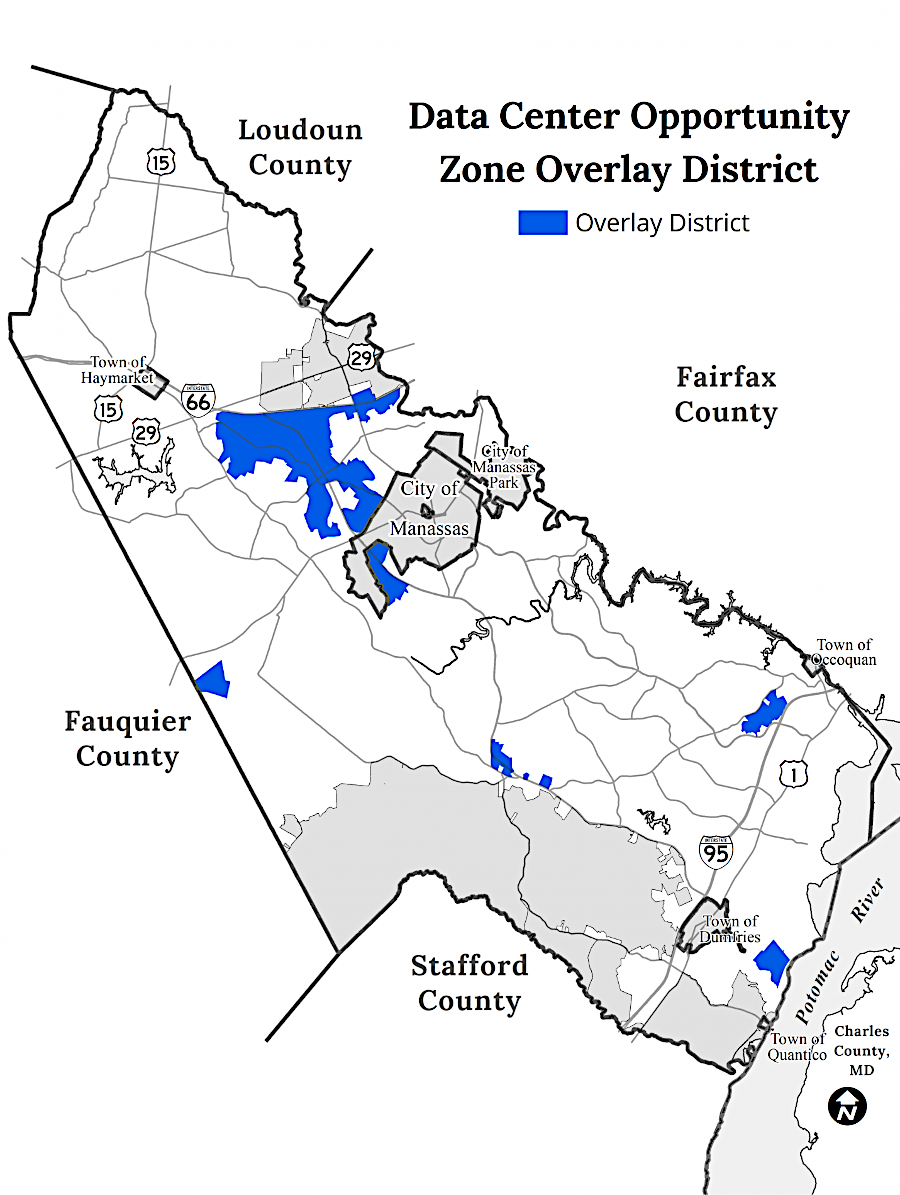
when Prince William County supervisors ignored the Data Center Opportunity Zone Overlay District in 2023, voters reacted in the primary election
Source: Prince William County, Data Center Opportunity Zone Overlay District Comprehensive Review
The Federal government recognized that new transmission lines would be needed, nationwide, as solar and wind projects created new generation centers. There were existing national grids, but connections between the Eastern Interconnection, Western Interconnection, and Texas Interconnected system were not adequate to transfer electricity from the middle of the country to the coastal areas. High voltage transmission lines link Virginia all the way to the Rocky Mountains, but the capacity of the grid is limited by the number and size of the wires stung from the towers.
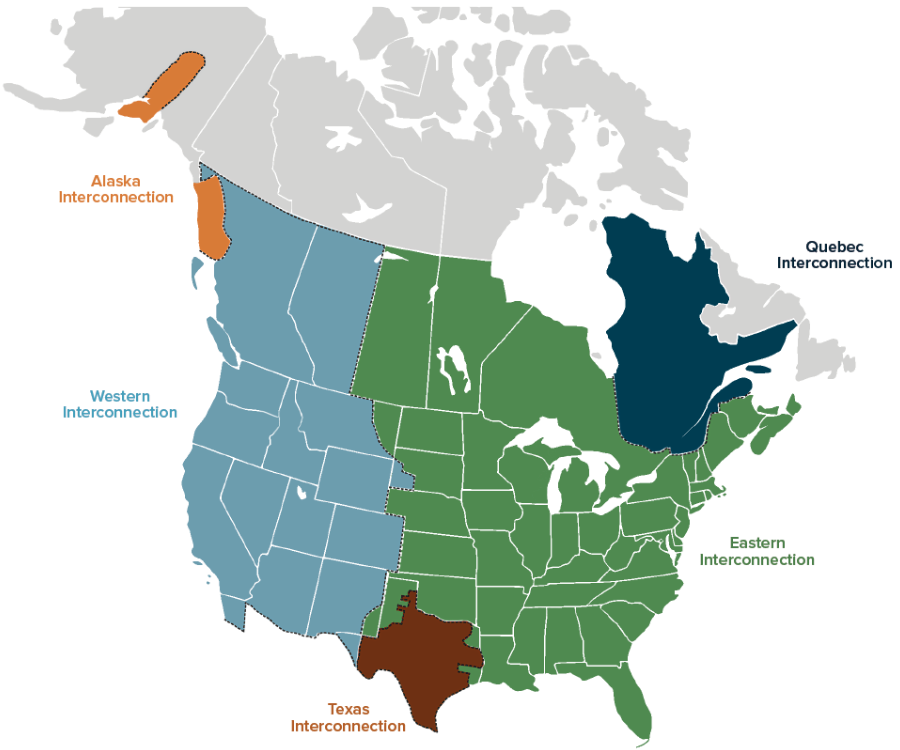
the transmission grid connects Virginia to states east of the Rocky Mountains - except Texas
Source: Congressional Budget Office, Enhancing the Security of the North American Electric Grid (Figure 1)
In 2022 the US Congress passed the Bipartisan Infrastructure Law authorizing $10.5 billion for upgrading transmission capacity. In 2023, Rappahannock Electric Cooperative was awarded $38 million in a grant from the Grid Resilience and Innovation Partnerships (GRIP) Program to deploy a distributed energy resources management system (DERMS). That would help the co-op, which would also provide $38 million, to build a robust fiber network providing real-time grid data. The upgraded network would enable load management with virtual power plants (VPPs), including distributed energy resources (DERs) and electric vehicles (EVs) scattered across the utility's service area.
Dominion Power also won a grant for Modernizing Infrastructure To Support Grid Management and Decarbonization. That investor-owned utility highlighted the opportunity to use electricity from its Coastal Virginia Offshore Wind project to deploy a 2-4MW BESS (Battery Energy Storage System) for a rural community, and to:17
New data centers in Northern Virginia required more electricity than the existing grid could transmit; demand began to exceed supply. In 2022, Dominion Energy issued a surprising alert that it could not meet the projected needs of new data centers in Eastern Loudoun County until completing new 500kv and 230kv transmission lines and substations in 2026.
The utility paused making commitments for new data center service connections for several months, and made clear that new facilities would initially receive only a percentage of their overall requested load. The power constraints could have driven data center developers to other locations, but one made clear that new construction would continue in Northern Virginia:18
There was little potential for building new electricity generation facilities in Northern Virginia, such as a twin for the 778MW Panda Stonewall Power Project located four miles south of south of Leesburg. That plant began operating on April 22, 2017. It runs on natural gas, and is cooled by reclaimed wastewater from the Leesburg sewage treatment plant.
Passage of the Virginia Clean Energy Act in 2020 constrained development of new generation facilities that would use fossil fuels. Solar panels could be located on top of buildings and parking lots - and on the small acreage of remaining open space in Northern Virginia - to provide local generation, but could meet only a small portion of the demand. Dominion Energy was required by state law to provide electricity to customers, so the utility's solution was to propose to import more electricity via the PJM grid to meet demand.
The demand increased even faster than the acreage planned for new data centers. The typical data center before 2020 required 30MW of electricity. By 2024, the power needs increased dramatically as data centers planned for computer servers with artificial intelligence (AI) chips. Dominion Energy told its stockholders in May, 2024 that the utility must invest heavily in constructing new transmission infrastructure to serve customers building the new power-hungry data centers:19
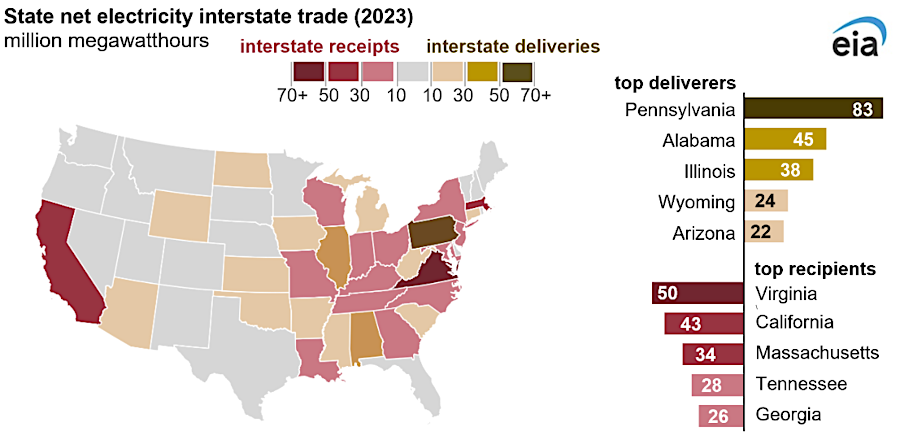
Virginia was the top net electricity recipient of any state in 2023
Source: US Energy Information Administration, Today in Energy (December 20, 2024)
PJM, the regional transmission organization that included Northern Virginia, predicted a 40% increase in transmission demand by 2039. The climb from 800,000 gigawatt-hours (GWh) to about 1.1 million GWh was due to data center expansion, the switch to electric vehicles (EVs), and electrification of multiple economic sectors (such as home heating) that were traditionally served by fossil fuels.
In the territory serviced by Dominion Energy in Virginia, the 2024 demand of 22,000MW was predicted to almost double to 42,000MW. PJM identified new transmission corridors to deliver electricity to Virginia from generation facilities located outside of the state.20
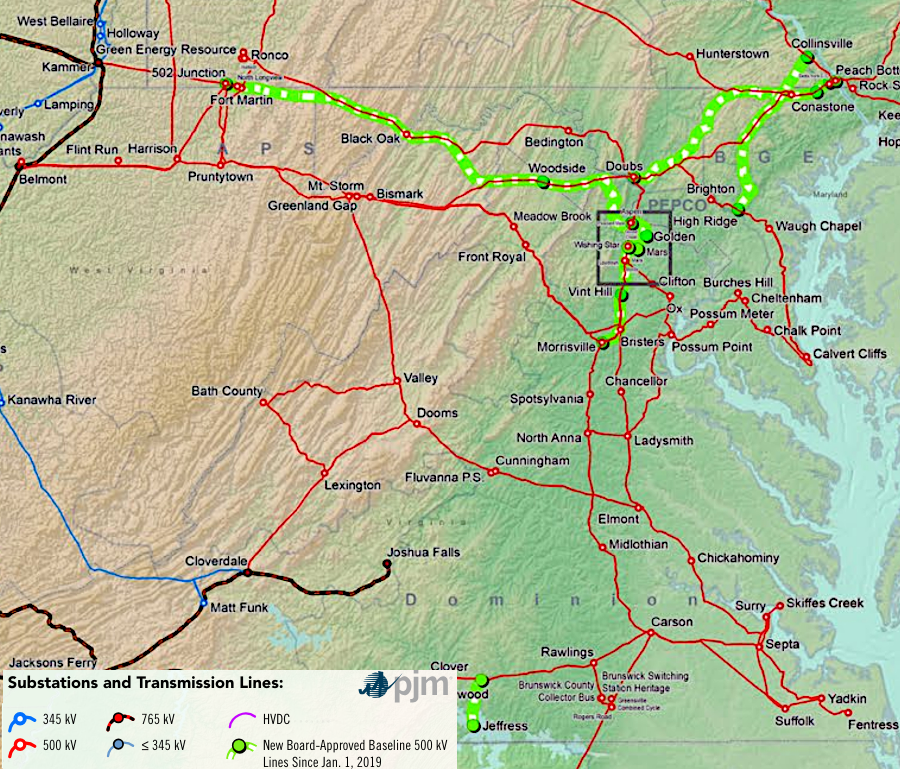
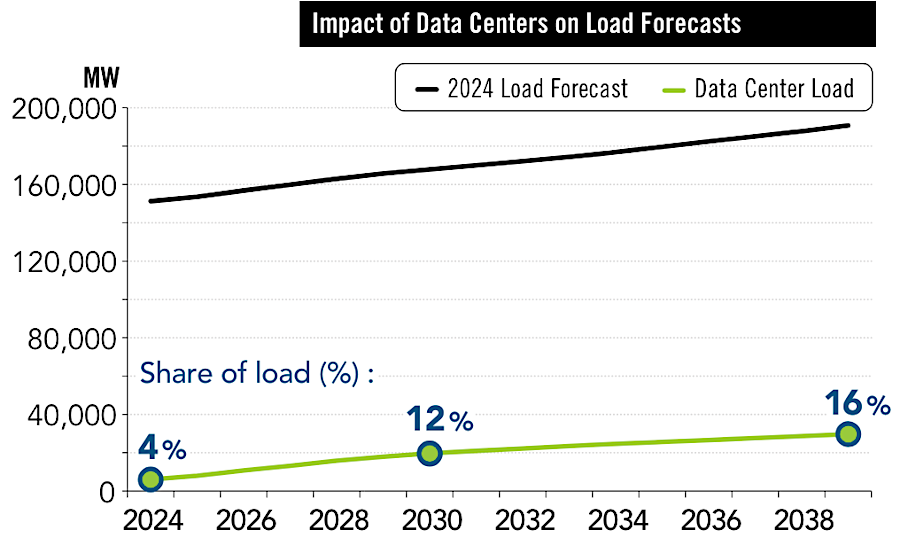
PJM plans to expand high-voltage transmission lines so Virginia can import more electricity, as demand from data centers increases
Source: PJM, Regional Transmission Expansion Planning Meeting The Grid’s Future Needs
At the Federal level, in May 2024 the US Department of Energy proposed 10 National Interest Electric Transmission Corridors (NIETCs) that would be eligible for federal funding and streamlined permitting. Federal designation of one of them, the Mid-Atlantic National Interest Electric Transmission Corridor, could lead to an approval process for interstate transmission lines that overrides objections by the Virginia State Corporation Commission (SCC) or General Assembly.21
A landowner in West Virginia, whose property would be used for a new transmission line to carry electricity from coal-fired power plants in the Ohio River Valley to Loudoun County, expressed the perspective that impacts were not balanced with benefits:22
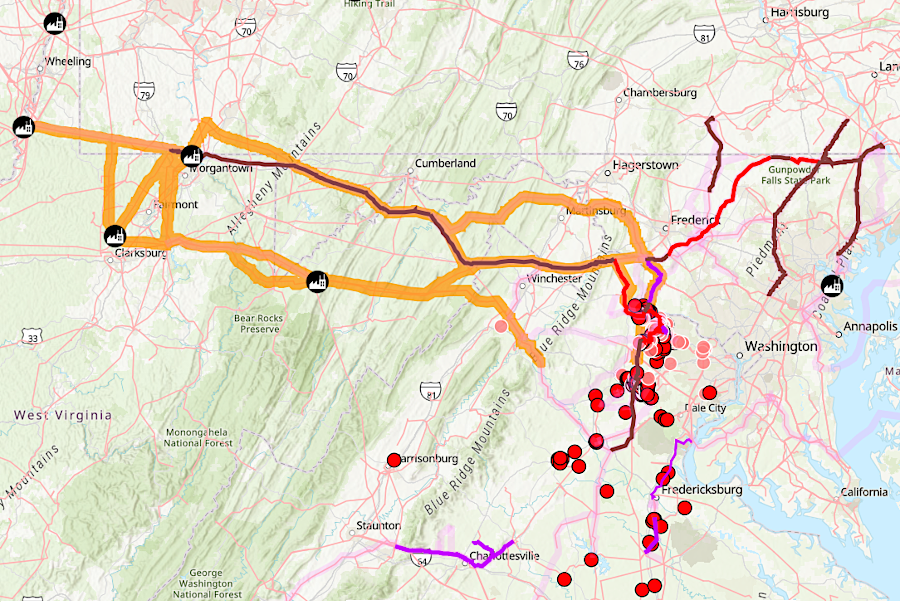
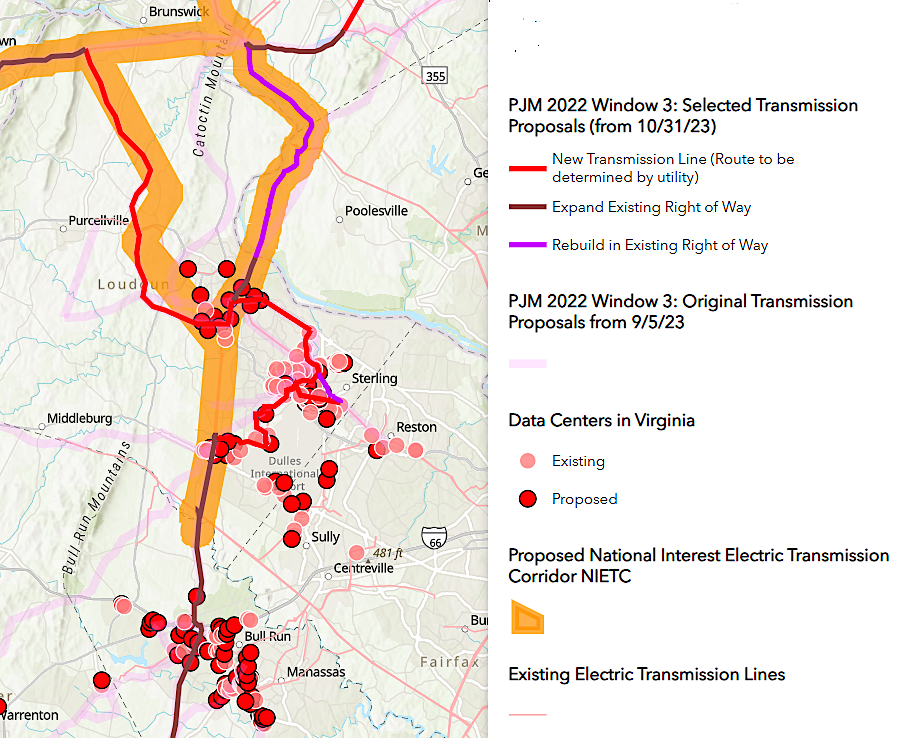
the Mid-Atlantic National Interest Electric Transmission Corridor would bring electricity from West Virginia power plants to data centers in Northern Virginia
Source: Piedmont Environmental Council (PEC), Initial Transmission Line Proposals to Serve Data Center Load Growth
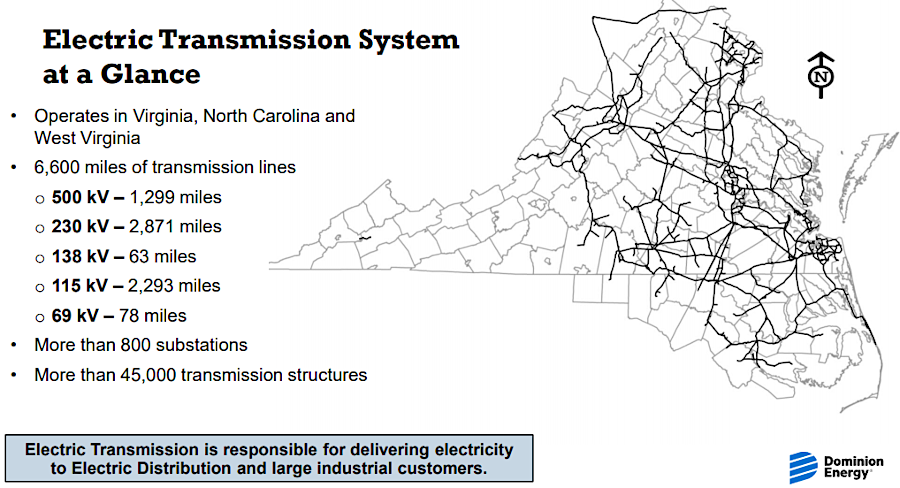
Dominion Power has high-voltage (69kV and above) transmission lines and low-voltage distribution lines
Source: Dominion Energy, Dominion Energy Electric Transmission Overview
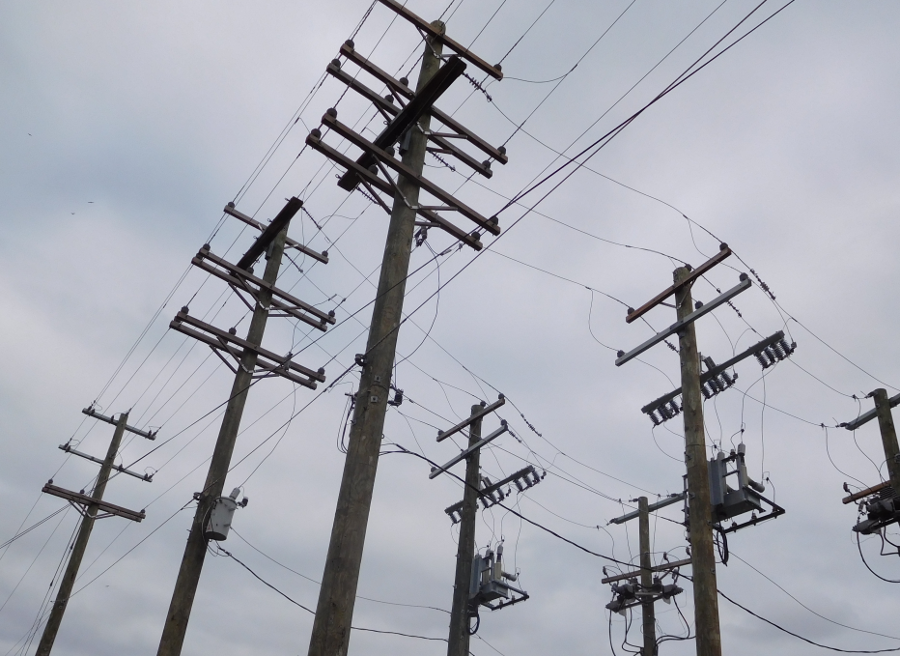
electricity generated at a few central power plants is distributed by a network of wires connecting to nearly every structure in Virginia

Dominion Energy has excess transmission capacity that varies in different areas, and no excess capacity in places without a line on the map
Source: Dominion Energy, Hosting Capacity Tool
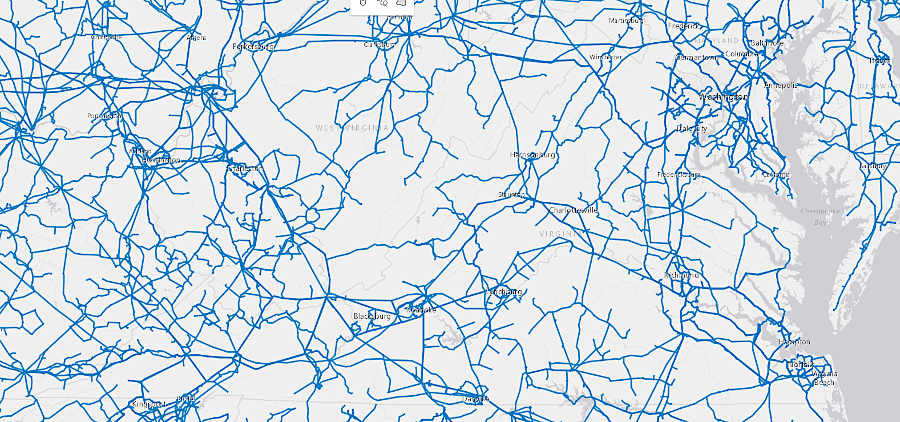
high voltage transmission lines move electricity across Virginia
Source: Department of Homeland Security, Electric Power Transmission Lines
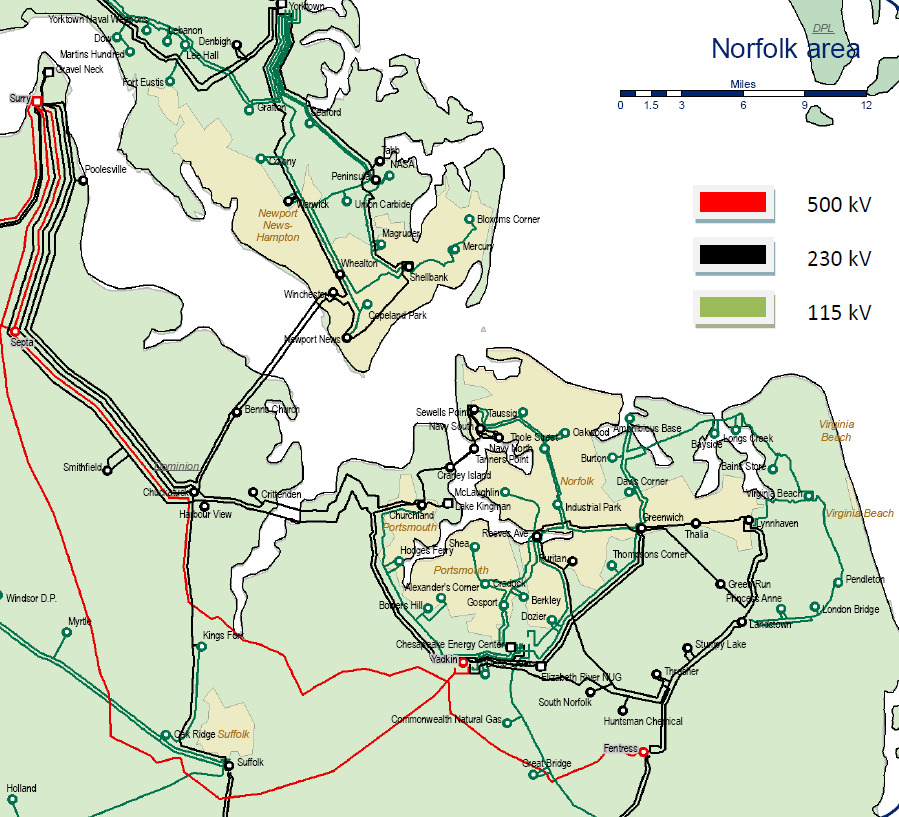
the nuclear power plant at Surry is a key node in the Hampton Roads transmission grid
Source: Dominion Virginia Power, Virginia Offshore Wind Integration Study (Figure C)
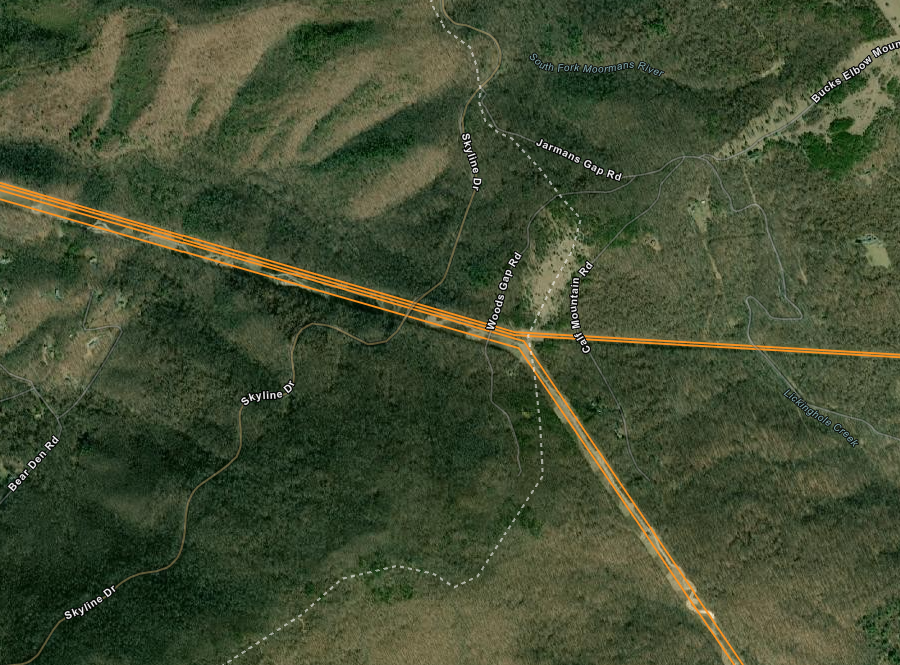
four high-voltage transmission lines, ranging from 115kV to 500kV, were routed to cross Skyline Drive and Appalachian Trail together to reduce visual impacts
Source: Homeland Infrastructure Foundation-Level Data (HIFLD), Electric Power Transmission Lines